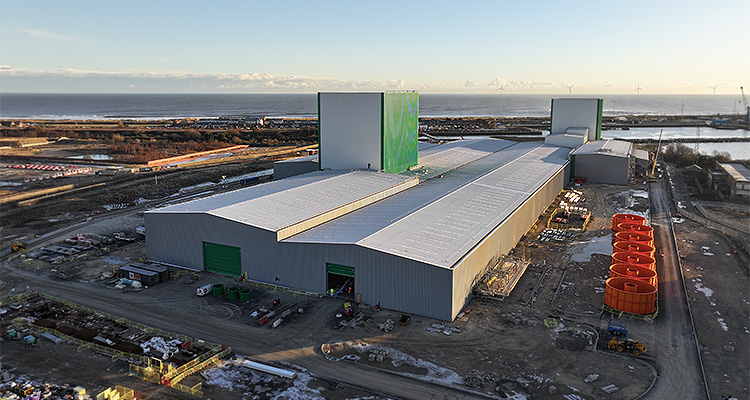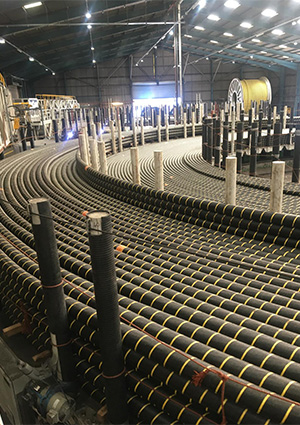
JDR Cable Systems Ltd drives innovation in offshore energy with cutting-edge subsea cable solutions
JDR Cable Systems Ltd (JDR) is going from strength to strength, leading the way in subsea cables for the offshore energy sector. Chief Strategy and Compliance Officer, James Young, outlines some of the major steps that have led to the company’s continued success: “The business is all about offshore energy. We’re also getting more involved in onshore energy, specifically the part that links to our offshore cables and umbilicals. We originally operated in the oil and gas sector but around 15 years ago diversified into offshore renewable energy and offshore wind in particular. The early successes we achieved in offshore renewables enabled us to build our new facility in Hartlepool, UK in 2009. This area of the business expanded rapidly in those early years, enabling us to invest further in Hartlepool to build more and more renewable energy cable products as the offshore wind sector grew. We quickly became one of the market leaders in array cables that provide the vital connection for turbines offshore.
Decarbonization efforts 
“We have continued pursuing growth and expansion, and now the business is completing the construction of its next facility. This will be our new high-voltage cable manufacturing facility at Cambois, in Northumberland. Once operational later this year, this facility will enable us to treble our cable production capacity for the renewable energy and subsea power cable product lines. As a result, we’ll also be hiring 171 new roles in Northumberland alongside safeguarding 270 roles throughout the rest of the UK. We’re very much staying here in the UK to support the growth of the offshore industry. We’ve got a lot of strong projects currently active and in the pipeline. As well as working in offshore energy production, we are also active in oil and gas decarbonization.
“For example, we’re working on projects involving carbon capture, usage, and storage; this represents an additional emerging line of business for us. It’s very important to capture CO₂ emissions from the industry alongside producing clean, renewable energy. This definitely constitutes a significant component of the net-zero journey. As a company, the push to net zero is of central importance and to reinforce that, we’ve just had our science-based targets validated by the Science-Based Target Initiative (SBTI), which allows us to show our customers how we’re progressing.
“We can see the significant growth in offshore wind to which the current and previous UK governments have committed. The latest UK government target is 60 gigawatts of offshore wind by 2030; we currently have 14.7 gigawatts plugged into UK networks. So, there’s a huge amount of additional offshore wind infrastructure that needs to be built. Of course, that requires not only the turbines, the towers, and the platforms but also the cables to bring that power back to shore. We’re in a really great place to support that market as those projects get constructed and delivered. Adding this extra capacity is essential to ensuring we can meet that increased demand.
Reducing emissions
 “In turn, we can help the industry and UK government deliver those targets, successfully growing our offshore wind capacity. As well as increasing our production capacity, we’re also moving up the voltage range; in the last year, we’ve moved from 66-kilovolt cables to 132-kilovolt cables. This allows us to provide more power on the cable systems. Moving up the voltage range also enables us to access the export cable market. These export cables are the larger cables bringing power from the wind farm back to shore and are currently imported to the UK. Our investments over the last three years are all coming together, facilitating a move into the high-voltage export cable market.
“In turn, we can help the industry and UK government deliver those targets, successfully growing our offshore wind capacity. As well as increasing our production capacity, we’re also moving up the voltage range; in the last year, we’ve moved from 66-kilovolt cables to 132-kilovolt cables. This allows us to provide more power on the cable systems. Moving up the voltage range also enables us to access the export cable market. These export cables are the larger cables bringing power from the wind farm back to shore and are currently imported to the UK. Our investments over the last three years are all coming together, facilitating a move into the high-voltage export cable market.
“In the new facility, a line is already in place that will allow us to go up to 275 kilovolts in the next two to three years. It takes over a year to test the prototypes once you’ve got the line operational. So, we will be working on that next year and then completing the long-term prototype cable testing in 2027.”
James goes on to highlight how JDR’s commitment to sustainability goes beyond its products: “We’re continually looking at our emissions. One of the areas we’re exploring to reduce our impact is the operation and running of our facilities. We’re working with lots of different groups and specialists to reduce our emissions end to end. For example, we decided very early on that the new Blyth facility will run entirely on electric energy, not gas.
Long-term planning
“This means we can have 100 percent renewable electricity, which will be the case this year. We’ve made that commitment. There are also a lot of other initiatives in place, including using low-emission lighting and reducing our waste through improvements in the manufacturing process. We’ve also been working with our supply chain to look at the whole carbon footprint of the product. When the cables have copper in them, for instance, it’s important to question where that copper comes from. Is it produced using renewable electricity or fossil fuels? We’ve been actively working with suppliers to secure lower-carbon copper material sourcing. There’s also an opportunity for increasing recycled content to close to 100 percent in some of those raw materials.
“For a business like ours, about 95 percent of our emissions come from our supply chain. Focusing on the supply chain is exactly the right thing to do. We then look to decarbonize each of those material supplies. In recent years, we have also been trialing sea freight rather than road freight, which has massively reduced our transportation emissions.
“These changes require a long-term plan; it can’t be done overnight, but the benefits are so significant that we are organizing our own supply chain day in July, where we will be talking about how we can encourage our supply chain to decarbonize their own operations, which could result in dramatic cost savings alongside doing the right thing for the environment.
“This is what we need to do to stop the impact of climate change. For some businesses, it’s quite daunting, as it was for us initially. If organizations work at it and collaborate with companies like ours, it’s possible to support the supply chain to understand where improvements can be made, and subsequent benefits realized.”
With an exciting future ahead, James shares his thoughts on the coming years: “We’ve future-proofed our new facility, ensuring we have the capabilities to expand. The market for offshore energy products is going to be huge in the decades to come, and we are perfectly placed to help build and maintain this crucial infrastructure,” he concludes.
